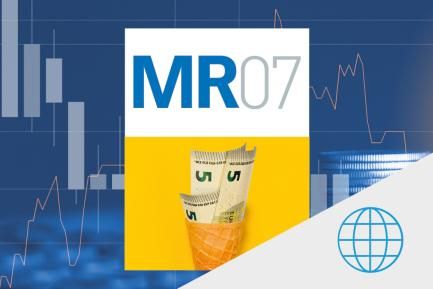
The Russia-Ukraine conflict, the new «black swan» of 2022

Things were looking up for the global economy, as COVID-19 looked set to take on a weaker, more flu-like form in the coming months. This was reflected in the substantial improvement in the main business and household confidence indicators in January and February, suggesting that we would see solid growth rates by mid-year and a slow but steady normalisation in the distortions of global supply chains. Economic agents were more concerned about the evolution of inflation and how it could affect the roadmap of the major central banks.
However, Putin’s decision on 22 February to recognise the independence of the separatist regions in eastern Ukraine (Donetsk and Luhansk) proved a turning point for the outlook. Events moved quickly in the last week of February, and the worst case scenario has finally materialised: war between Russia and Ukraine. The big questions now are, on the one hand, how long the conflict itself and its effects on confidence and energy prices will last and, on the other hand, what the impact of the sanctions on Russia will be.

Russia’s ability to affect the global economy lies not in its size – its economy is only slightly bigger than Italy’s, and it is also fairly closed – but rather in its role as the main producer of a number of key commodities. Furthermore, this new shock comes at a time when global supply chains have not yet normalised following the outbreak of the COVID-19 pandemic, which will aggravate the supply problems that a significant portion of the industrial fabric is already experiencing. The impact will be asymmetric and especially significant for Europe, as Russia is the region’s fifth largest trading partner: Germany is one of the countries most exposed to the trade channel, with 2.0% of its exports going to Russia, representing around 0.6% of its gross value added (GVA).

The region is highly dependent on fossil fuels in general and on those from Russia in particular. According to the ECB, around 80% of the energy consumed in the euro area corresponds to gas and oil. Moreover, Russia accounts for almost 46% of the gas imported into the region, and inventory levels are some 30% below the February average of the last 10 years. This leaves the continent quite vulnerable if Russia decides to cut the supply. According to ECB estimates, a 10% reduction in the supply of gas would result in a 0.7-pp reduction in the euro area’s GVA. By country, Germany would be the hardest hit, given that almost 65% of its gas imports come from Russia. Considering that Q1 2022 was already looking very weak before the outbreak of the war, with another fall in economic activity being a real possibility, the outlook is looking particularly difficult for Germany. As a result, the risks to the euro area are largely skewed to the downside for growth and to the upside for inflation. Although it is still too early to quantify the magnitude of these revisions, in an initial sensitivity analysis we estimate an impact exceeding 1 pp in the case of euro area growth in 2022.

Russia faces severe sanctions for the attack on Ukraine, although the policy of sanctions is not new to Russia, as it is still facing some of those imposed after the annexation of Crimea in 2014. The IMF estimated that those measures subtracted 0.2 pps from Russia’s annual growth during the period 2014-2018, a decline that was exacerbated by the sharp drop in the price of crude oil in the same period (which may have subtracted an additional 0.6 pps per year). Today, Russia’s war against Ukraine has led the major Western powers to impose a new round of heavy sanctions which, according to some estimates, could cut Russia’s GDP by 5.0%. Broadly speaking, the sanctions adopted, in addition to directly affecting the assets and wealth of Putin and other Russian oligarchs, cut Russia’s access to international financing markets, they limit the use of the reserves amassed by the central bank and they affect the activity of around 70% of the country’s financial sector.

Since the invasion of Crimea in 2014, Russia has accumulated reserves in excess of 600 billion dollars (almost 40% of its GDP). The EU, the US, the UK and Canada have decided to «freeze the assets of the central bank» in order to limit its ability to defend the rouble, as well as to prevent those funds from being used to offset the impact of the sanctions. The potential effectiveness of this measure becomes evident when analysing the composition of these reserves. Around 160 billion dollars corresponds to gold (stored within the country) and some 90 billion is held in yuan. However, the reserves denominated in currencies of the countries that have joined the sanctions represent almost 60% of the total.

After intense debate, it was decided to exclude a number of Russian banks from the Swift international payments system (which connects over 11,000 financial institutions around the world). It is true that Russia has been working on its own payment system since 2014 (the SPFS), but it covers only around 400 institutions, most of them Russian, so the volume of orders it transmits is small. Therefore, the entities excluded from Swift will not be able to process flows of funds from outside the country, posing a severe blow to Russia’s export sector.
Thus, the extent and severity of the measures imposed against Russia will limit its trade with the rest of the world, significantly restrict the operations of the financial channel, drain much of the liquidity and could even end up causing a price spiral and a sharp depreciation of the rouble. Ultimately, this will lead to capital controls being imposed, and a recession. There are no precedents for such significant sanctions in recent years, with the exception of Iran and North Korea.

Most emerging economies raised interest rates to a greater or lesser extent during 2021 in an attempt to slow the advance of inflation. In this way, they extended the freedoms of economic policy to respond to potential surprises in the economic scenario. However, we must bear in mind that in the current context of heightened uncertainty and rising commodity prices, the impact will be somewhat uneven across economies.

The economies of Eastern Europe will be the hardest hit. One example of evidence that that contagion is already spreading to the region is the ECB’s statement that the European subsidiary of the Russian bank Sberbank and its two subsidiaries in Croatia and Slovenia are either bankrupt or are likely to fail soon due to the deterioration in their liquidity.
Commodity-exporting economies, with a surplus in their current account balance, will benefit the most from the price rises that have already accumulated in the main commodities. On the other hand, commodity-importing economies, which traditionally run deficits in their current account balances, will be the most vulnerable and will find it the hardest for their economic policy to respond to the new scenario. Also, the region in conflict is known as the «breadbasket of Europe»: wheat from Russia and Ukraine supplies northern Africa, sub-Saharan Africa, the Middle East, and Southeast Asia. These regions encompass economies with very low incomes, so the inevitable sharp rise in the price of this commodity (already up almost 80% so far this year) could fuel social tensions. Finally, in the current context of high uncertainty, we could see an outflow of capital from emerging economies towards «safer» destinations, and this could destabilise the most vulnerable economies.

In short, the heightened geopolitical risk will pose a new shock for the international economy, just when we were beginning to see the light at the end of the tunnel in the pandemic. It is too early to estimate the effects on the main economic and financial variables. However, the heightened uncertainty and the volatility we will see in energy prices will force economic policy to respond in an attempt to minimise the effects of this umpteenth disruption to the international cycle in recent years.



